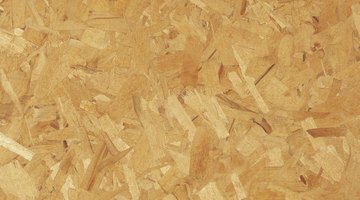How to Cover a Chipboard Wall
Chipboard refers to board which consists of wood chips, wood shavings and other comparable materials. It is a cheap alternative to standard wood material for building furniture and room dividers. One of the drawbacks, however, is its unsightly and textured appearance.

Chipboard can be replaced with nicer cuts of wood, though this is not always an option. Fortunately, an unsightly chipboard wall can be covered with paint.
Things You Will Need
- 100-grit sandpaper
- Electric sander
- Soft cloth
- Mineral spirits
- Oil-based primer
- Paint roller pan with 3 liners
- Paint roller
- Oil-based paint
- Polyurethane
-
Attach a piece of 100-grit sandpaper to the bottom of an electric sander and run the sander back and forth across the chipboard. Sanding will remove surface flaws and helps to soften the texture of the chipboard.
-
Moisten a soft cloth with mineral spirits and wipe down the wall. This will remove the dust from sanding.
-
Pour an oil-based primer into your paint roller pan. Prime the wall with a generous coat of primer. This will help to even out the texture of the chipboard wall.
-
Using a new liner, pour your oil-based paint into the roller pan and apply a light coat of paint to the wall, rolling it on evenly. Allow it to dry overnight and apply a second coat. Allow 24 hours for the second coat to dry.
-
Pour clear polyurethane finish into a clean roller pan liner. Apply a light coat to the wall to seal it. Allow it to dry overnight.
The Drip Cap
- Chipboard refers to board which consists of wood chips, wood shavings and other comparable materials.
- It is a cheap alternative to standard wood material for building furniture and room dividers.
- Using a new liner, pour your oil-based paint into the roller pan and apply a light coat of paint to the wall, rolling it on evenly.
- Allow it to dry overnight and apply a second coat.
References
- "Designer's Guide to Surfaces and Finishes"; Penny Radford; 1991
Writer Bio
Lane Cummings is originally from New York City. She attended the High School of Performing Arts in dance before receiving her Bachelor of Arts in literature and her Master of Arts in Russian literature at the University of Chicago. She has lived in St. Petersburg, Russia, where she lectured and studied Russian. She began writing professionally in 2004 for the "St. Petersburg Times."
Photo Credits
- Liquidlibrary/liquidlibrary/Getty Images
- Liquidlibrary/liquidlibrary/Getty Images
More Articles



